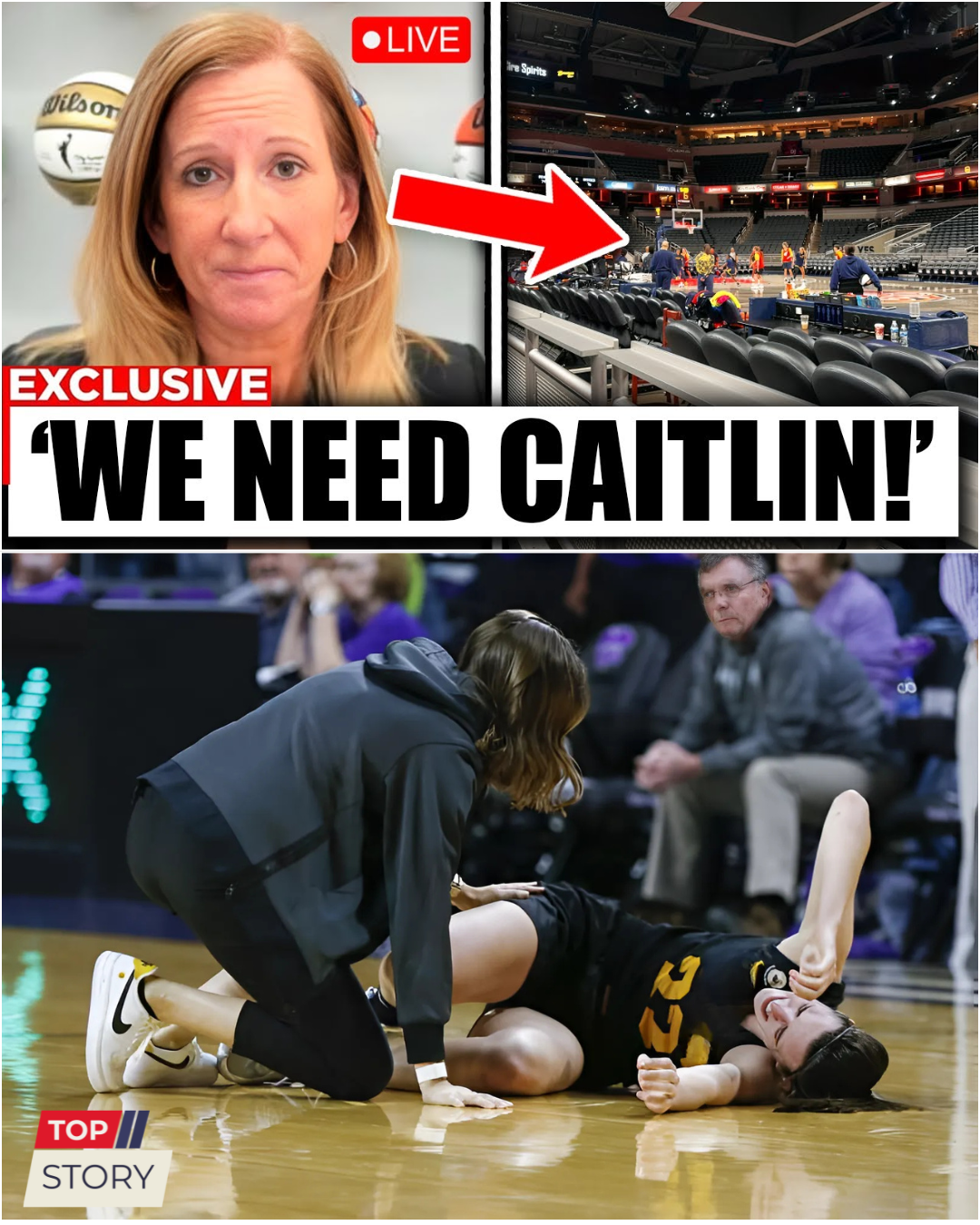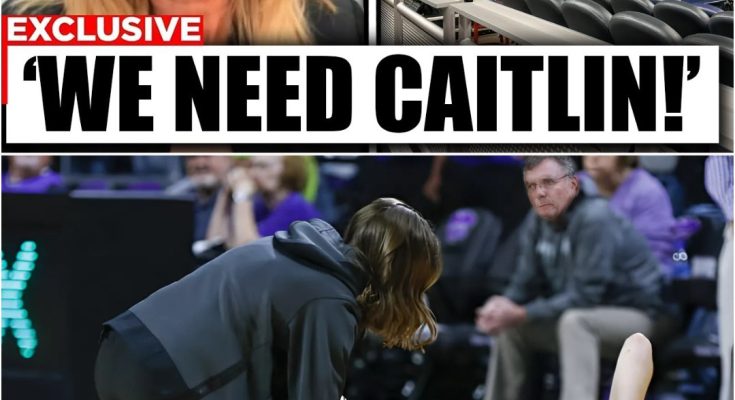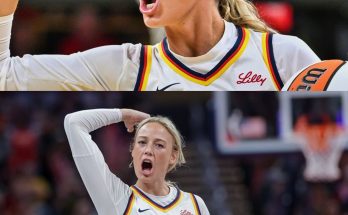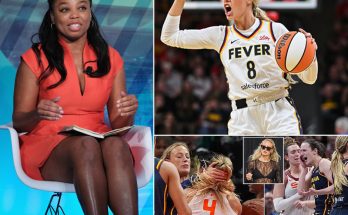
It began with a muscle strain. A standard groin injury — the kind that keeps most players out for a week or two. But when Caitlin Clark missed a handful of games in June, it wasn’t just her team that took a hit.
The entire league did.
Ratings plummeted. Ticket prices collapsed. The energy shifted.
And for the second time in her rookie season, the WNBA was reminded — brutally and publicly — that its entire media ecosystem, audience momentum, and financial forecast had become dangerously dependent on one 22-year-old rookie guard.
The Numbers Weren’t Subtle. They Were Alarming.
Before the injury, Indiana Fever games featuring Caitlin Clark were averaging 1.81 million viewers on national television. Without her?
That number dropped to 847,000.
A staggering 53% decline in viewership.
Across the league, the damage was even worse: a 55% drop in average national audience size during the five-game stretch Clark missed.
This isn’t a blip. This is a freefall.
And it’s the second time it’s happened.
Earlier this season, when Clark sat out with a quad strain in May, the same pattern emerged. Ticket resale prices cratered. National attention evaporated. Games that were once appointment viewing turned into empty chairs and empty feeds.
The message was loud — and it wasn’t kind.
This league, for all its institutional history and collective talent, is currently being held up by one player.
Clark Isn’t Just the Face of the Fever — She’s the Lifeline of the League
That’s a bold statement. But at this point, it’s hard to dispute.
Clark’s games routinely break WNBA viewership records. Her jersey remains the best-selling item in women’s sports. Road teams relocate games to larger venues just to accommodate the demand when she visits. Entire arena crowds show up in her college jersey.
And when she’s not on the court?
The WNBA looks like it did three years ago — quiet, niche, forgettable.
It’s not an indictment of the players. It’s an indictment of how little infrastructure the league has built to support true star power.
Because when you’ve got something this rare — this culturally potent — and you don’t protect it?
You don’t just lose games.
You lose ground.
And the League’s Response? Silence. Shrugs. More “Basketball Plays.”
The outrage didn’t come from Clark. It came from the outside.
From analysts. From journalists. From viewers watching in disbelief as Clark continued to be targeted by hard fouls, blindsides, and contact that looked less like defense and more like statements.
Of the WNBA’s 30 flagrant fouls this season, five were committed against Caitlin Clark. Four of those came from the same team.
And yet, when questioned, league officials repeatedly cited “competitive physicality” and “letting players play.”
But the viewers noticed. And so did the numbers.
You can call it tough defense.
But fans are calling it something else: negligence.
Christine Brennan: “One Player Is Out, and Half the League’s Audience Disappears”
Veteran journalist Christine Brennan said the quiet part loud in a viral tweet:
“One player gets injured and more than half the TV audience for the entire league disappears. Has any other athlete ever had that kind of impact on a sport?”
Tiger Woods. Maybe Michael Jordan. But even they didn’t cause this kind of weekly volatility in revenue and ratings just by missing a few games.
That level of leverage is rare. And it’s not just a compliment.
It’s a crisis.
Because when a league is this dependent on a single player — especially one in her first year — it doesn’t reflect strength.
It reflects fragility.
The League Had a Chance to Protect Its Star. It Chose to Watch Instead.
Clark didn’t complain publicly.
She kept playing. Kept showing up. Kept giving postgame interviews where she praised her teammates and stayed diplomatic.
But as she absorbed hard foul after hard foul — as she watched the headlines pile up and the league stay silent — it became clear that the WNBA wasn’t prepared to defend its most valuable asset.
And now, they’re paying for that decision.
Broadcast ratings are plummeting.
Sponsors are getting nervous.
Viewership has fallen back to pre-Clark levels.
The problem isn’t just that Caitlin Clark is hurt.
The problem is that no one seems to know what to do when she is.
The Financial Collapse Was Immediate. And Brutal.
When Caitlin Clark went down, the money didn’t just slow — it vanished.
Ticket prices for Fever road games fell by over 70%. One resale site showed average prices plunging from $860 to just $250. In some cases, from over $1,300 down to $80.
Games that had been moved to larger arenas to handle “Clark crowds” suddenly had entire rows of empty seats.
The rematch between Indiana and Chicago — once billed as the league’s most-watched rivalry — saw ticket prices fall from $210 to under $95. Without Clark, it became just another regular season game.
And that, perhaps, is the most painful truth of all.
Without Caitlin Clark, most WNBA games are just another game.
The Sponsors Are Starting to Notice
Corporate partners — many of whom had poured investment into the WNBA precisely because of Clark’s cultural rise — are now facing harsh questions in boardrooms.
Where’s the ROI?
Where are the numbers?
What happens next time she’s out?
For a league already projected to lose $50 million this year even with Clark on the floor, these trends are not just worrisome. They’re potentially existential.
And unless something changes — fast — they may start pulling out.
Meanwhile, the Narrative Has Slipped Away
The WNBA had a golden chance to frame this season as the dawn of a new era.
Instead, it’s become a loop.
Clark gets fouled hard.
Referees call nothing.
She gets injured.
Ratings crash.
League releases a bland statement.
Fans get angrier.
And then… it happens again.
What should have been a launchpad now looks like a cautionary tale.
And the players? The ones working just as hard as Clark but not getting the same attention?
They’re caught in the middle — stuck between a league unwilling to defend its own and a fanbase losing faith by the day.
This Was Preventable. And That’s the Tragedy
Clark didn’t ask for this spotlight. But she earned it.
She broke records. Sold out arenas. Brought millions of new eyes to the game.
She handled criticism with grace. Deflected praise toward her teammates. Played through pain.
And yet, the WNBA failed to build any protective structure around her. No clear flagrant foul policy. No public backing. No sense that anyone had her back when it mattered most.
Now, the golden goose is limping.
And the people who built their season around her shine are scrambling to explain why they didn’t see this coming.
This Isn’t Just About Sports Anymore
When tens of thousands of families — many of them first-time WNBA viewers — buy tickets to see Caitlin Clark, they’re not just buying into a game.
They’re buying into hope.
Hope that the league will finally embrace its moment.
Hope that women’s sports will be given the respect they deserve.
Hope that their daughters will see a future on the court worth chasing.
But when those same families tune in and see Clark repeatedly hit the floor with no call?
When they read headlines about her injury and silence from the league?
When they watch the viewership numbers collapse with her absence?
They ask themselves the same question:
“If they won’t protect her… why should I care?”
The WNBA Needs to Decide What It Wants to Be
Does the league want to be taken seriously? Then it needs to act like a professional league.
That means protecting its stars. Enforcing clear rules. Putting basketball ahead of politics.
Or does it want to keep chasing headlines and hashtags?
Because right now, it looks like a brand that stumbled into success — and has no idea how to hold onto it.
Final Freeze: The Spotlight Isn’t the Problem — The Silence Is
The WNBA didn’t fail because Caitlin Clark got hurt.
It failed because it never built a system that could survive without her.
One player should never carry an entire sport. And yet, here we are.
The viewership drop is real. The financial dip is undeniable. The tension in the fanbase is growing.
But there’s still time to fix it.
Time to protect the stars who actually fill the seats.
Time to prioritize the product over performative politics.
Time to decide if this league is finally ready to grow up — or if it’s content to stumble from crisis to crisis, burning out the only people keeping it alive.
The next time Clark steps back on that court, millions will be watching.
The only question is:
Will the league finally show up too?



